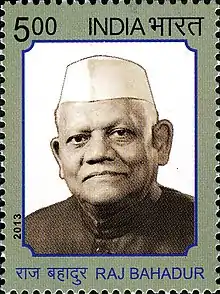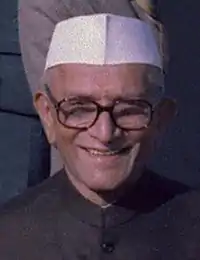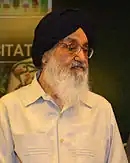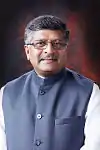Ministry of Communications (India)
Ministry of Communications is a Central ministry under the Government of India responsible for telecommunications and postal service. It was carved out of Ministry of Communications and Information Technology on 19 July 2016.
 | |
| Ministry overview | |
|---|---|
| Preceding Ministry | |
| Jurisdiction | Government of India |
| Headquarters | Sanchar Bhawan 20, Ashoka Road, New Delhi, Delhi, India |
| Annual budget | ₹123,393 crore (US$15 billion) (2023-24 est.)[1] |
| Ministers responsible | |
| Ministry executives | |
| Child agencies | |
| Website | dot |
It consists of two departments viz. Department of Telecommunications and the Department of Posts.
Formation
Ministry of Communication and Information Technology was bifurcated into Ministry of Communications and Ministry of Electronics and Information Technology.[2]
Department of Telecommunications
Also known as the Door Sanchar Vibhag, this department concerns itself with policy, licensing and coordination matters relating to telegraphs, telephones, wireless, data, facsimile and telematic services and other similar forms of communications. It also looks into the administration of laws with respect to any of the matters specified, namely:
- The Indian Telegraph Act, 1885 (13 of 1885)
- The Indian Wireless Telegraphy Act, 1940 (17 of 1933)
- The Telecom Regulatory Authority of India Act, 1997 (24 of 1997)
Central public sector undertakings
R&D unit
Specialised units
- Wireless Planning and Coordination Wing
- Telecom Engineering Center[3]
- Controller of Communication Accounts
- Telecom Enforcement Resource and Monitoring (TERM) cells, formerly known as Vigilance & Telecom Monitoring (VTM) cells
In 2007, in order to distinctly address the issues of Communication Network Security at DOT (HQ) level, consequent to enhancement of FDI limit in Telecom sector from 49% to 74%, a new wing named Security was created in DOT (HQ).
Objectives
- e-Government: Providing e-infrastructure for delivery of e-services
- e-Industry: Promotion of electronics hardware manufacturing and IT-ITeS industry
- e-Innovation / R&D: Implementation of R&D Framework - Enabling creation of Innovation/ R&D Infrastructure in emerging areas of ICT&E/Establishment of mechanism for R&D translation
- e-Learning: Providing support for development of e-Skills and Knowledge network
- e-Security: Securing India's cyber space
- e-Inclusion: Promoting the use of ICT for more inclusive growth
- Internet Governance: Enhancing India's role in Global Platforms of Internet Governance.
Telephone Advisory Committees
- Telephone Advisory Committees[4][5][6][7][8]
- MTNL Website list of TAC members
- National Institute of Electronics and Information Technology
- National Institute of Communication Finance
- National Agriculture Education Institute of Research & Resources India
Department of Posts
The Department of Post (DoP) which wholly the India Post operates one of the oldest and most extensive mail services in the world. As of 31 March 2017, the Indian Postal Service has 154,965 post offices, of which 139,067 (89.74%) are in rural areas and 15,898 (10.26%) are in urban areas. It has 25,585 departmental PO s and 129,380 ED BPOs. At the time of independence, there were 23,344 post offices, which were primarily in urban areas. Thus the network has registered a sevenfold growth since independence, with the focus of the expansion primarily in rural areas. On average, a post office serves an area of 21.56 sq; km and a population of 7,753 people. This is the most widely distributed post office system in the world.[9] The large numbers are a result of a long tradition of many disparate postal systems which were unified in the Indian Union post-Independence. Owing to this far-flung reach and its presence in remote areas, the Indian postal service is also involved in other services such as small savings banking and financial services, with about 25,464 full-time and 139,040 part-time post offices. It offers a whole range of products under posts, remittance, savings, insurance, and philately. While the Director-General is the head of operations, the Secretary is an adviser to the Minister. Both responsibilities are undertaken by one officer.
The DG is assisted by the Postal Services Board with six members: The six members of the Board hold portfolios of Personnel, Operations, Technology, Postal Life Insurance, Banking, Planning respectively. Shri Ananta Narayan Nanda is the Secretary (Posts) also the Chairman of the Postal Services Board and Ms.Meera Handa is Director General (DG) Posts. Shri.Vineet Pandey(Additional Charge) Additional Director General(Coordination) (ADG), Ms. Arundhaty Ghosh, Member (Operations), Shri. Biswanath Tripathy, Member (Planning), Shri Pradipta Kumar Bisoi, Member (Personnel), Shri Udai Krishna, Member (Banking), Shri Salim Haque, Member (Technology) and Shri. Vineet Pandey, Member (PLI) & Chairman, Investment Board. The national headquarters are at Delhi and functions from Dak Bhavan located at the junction of Parliament Street and Ashoka Road.
The total revenue earned including remuneration for Savings Bank & Savings Certificate work during the year 2016-17 was ₹11,511.00 crores and the amount received from other Ministries/ Departments as Agency charges (recoveries) was ₹730.90 crores and expenditure is ₹24,211.85 crores during 2016–2017 against the previous year expenditure of ₹19,654.67 crores. The increase was mainly due to payment of increased pay & allowances consequent upon implementation of 7th pay commission recommendations, leave encashment during LTC, cost of materials, oil, diesel, revision of service tax on government buildings etc.
Lack of proper investment in infrastructure and technology is the reason for such low revenue. The present top management has already started investing in the latest technology to improve the infrastructure. Quality of service is being improved and new products are being offered to meet the competition.
The field services are managed by Postal Circles—generally conforming to each State—except for the North Eastern States, India has been divided into 22 postal circles, each circle headed by a Chief Postmaster General. Each Circle is further divided into Regions comprising field units, called Divisions, headed by a Postmaster General. Further divided into divisions headed by SSPOs & SPOs. further divisions are divided into Sub Divisions Headed by ASPs & IPS. Other functional units like Circle Stamp Depots, Postal Stores Depots, and Mail Motor Service may exist in the Circles and Regions.
Besides the 23 circles, there is a special Circle called the Base Circle to cater to the postal services of the Armed Forces of India. Army Postal Services (APS) is a unique arrangement to take care of the postal requirement of soldiers posted across the country. Department of Posts personnel is commissioned into the army to take care of APS. The Base Circle is headed by an Additional Director General, Army Postal Service, holding a Major general.<ref>Cheap Eggs Over Animal Welfare
The DoP is governed by the Indian Post Office Acts, 1898. Other than the traditional postage service to keep up with the age, many new services have been introduced by the department:
- e-Post - Delivery of email through postman where email service is not available
- e-BillPost - Convenient way to pay bills under one roof
- Postal Life insurance
- International money transfers
- Mutual funds
- Banking
List of ministers
| # | Portrait | Name | Term of office | Prime Minister | Party | |||
|---|---|---|---|---|---|---|---|---|
| Ministry of Communications and Information Technology | ||||||||
| 1 |  |
Rafi Ahmed Kidwai | 15 August 1947 | 2 August 1951 | 3 years, 352 days | Jawaharlal Nehru | Indian National Congress | |
| 2 | .jpg.webp) |
Amrit Kaur | 2 August 1951 | 13 May 1952 | 285 days | |||
| 3 |  |
Jagjivan Ram | 13 May 1952 | 7 December 1956 | 4 years, 208 days | |||
| 4 |  |
Raj Bahadur | 7 December 1956 | 17 April 1957 | 131 days | |||
| 5 | .jpg.webp) |
Lal Bahadur Shastri | 17 April 1957 | 28 March 1958 | 345 days | |||
| 6 | .jpg.webp) |
S. K. Patil | 29 March 1958 | 24 August 1959 | 1 year, 148 days | |||
| 7 |  |
Jawaharlal Nehru | 25 August 1959 | 2 September 1959 | 8 days | |||
| 8 |  |
P. Subbarayan | 2 September 1959 | 9 April 1962 | 2 years, 219 days | |||
| (3) |  |
Jagjivan Ram | 10 April 1962 | 31 August 1963 | 1 year, 144 days | |||
| 9 |  |
Ashoke Kumar Sen | 1 September 1963 | 13 June 1964 | 286 days | |||
| Lal Bahadur Shastri | ||||||||
| 10 | – | Satya Narayan Sinha | 13 June 1964 | 12 March 1967 | 2 years, 272 days | |||
| Indira Gandhi | ||||||||
| 11 |  |
Ram Subhag Singh | 13 March 1967 | 14 February 1969 | 1 year, 338 days | |||
| (10) | – | Satya Narayan Sinha | 14 February 1969 | 8 March 1971 | 2 years, 22 days | |||
| 12 |  |
Indira Gandhi | 9 March 1971 | 17 March 1971 | 8 days | |||
| 13 | – | Sher Singh | 18 March 1971 | 2 May 1971 | 45 days | |||
| 14 |  |
Hemvati Nandan Bahuguna | 2 May 1971 | 8 November 1973 | 2 years, 190 days | |||
| (4) |  |
Raj Bahadur | 8 November 1973 | 11 January 1974 | 64 days | |||
| 15 |  |
Kasu Brahmananda Reddy | 11 January 1974 | 10 October 1974 | 272 days | |||
| 16 |  |
Shankar Dayal Sharma | 10 October 1974 | 24 March 1977 | 2 years, 165 days | |||
| 17 |  |
Morarji Desai | 24 March 1977 | 26 March 1977 | 2 days | Morarji Desai | Janata Party | |
| 18 |  |
Parkash Singh Badal | 26 March 1977 | 27 March 1977 | 2 days | Shiromani Akali Dal | ||
| 19 | .jpg.webp) |
George Fernandes | 28 March 1977 | 6 July 1977 | 100 days | Janata Party | ||
| 20 | – | Brij Lal Varma | 6 July 1977 | 28 July 1979 | 2 years, 22 days | |||
| 21 |  |
Charan Singh | 28 July 1979 | 30 July 1979 | 2 days | Charan Singh | Janata Party (Secular) | |
| 22 | – | Zulfiquarullah
(I/C) |
30 July 1979 | 27 November 1979 | 120 days | |||
| (21) |  |
Charan Singh | 27 November 1979 | 7 December 1979 | 10 days | |||
| 23 | – | Shyam Nandan Mishra | 7 December 1979 | 14 January 1980 | 38 days | |||
| (12) |  |
Indira Gandhi | 15 January 1980 | 16 January 1980 | 1 day | Indira Gandhi | Indian National Congress | |
| 24 |  |
Bhishma Narain Singh | 16 January 1980 | 3 March 1980 | 47 days | |||
| 25 | – | C. M. Stephen | 3 March 1980 | 2 September 1982 | 2 years, 183 days | |||
| 26 | Anant Prasad Sharma | 2 September 1982 | 14 February 1983 | 165 days | ||||
| (12) |  |
Indira Gandhi | 14 February 1983 | 31 October 1984 | 1 year, 260 days | |||
| 27 | .jpg.webp) |
Rajiv Gandhi | 31 October 1984 | 4 November 1984 | 4 days | Rajiv Gandhi | ||
| 28 | – | V. N. Gadgil | 4 November 1984 | 31 December 1984 | 57 days | |||
| 29 | .jpg.webp) |
Ram Niwas Mirdha
(I/C) |
31 December 1984 | 22 October 1986 | 1 year, 295 days | |||
| 30 |  |
Arjun Singh | 22 October 1986 | 14 February 1988 | 1 year, 115 days | |||
| 31 | – | Vasant Sathe | 14 February 1988 | 25 June 1988 | 132 days | |||
| 32 | – | Bir Bahadur Singh | 25 June 1988 | 30 May 1989 | 339 days | |||
| (27) | .jpg.webp) |
Rajiv Gandhi | 31 May 1989 | 4 July 1989 | 34 days | |||
| 33 | .jpg.webp) |
Giridhar Gamang
(I/C) |
4 July 1989 | 2 December 1989 | 151 days | |||
| 34 | .jpg.webp) |
V. P. Singh | 2 December 1989 | 6 December 1989 | 4 days | V. P. Singh | Janata Dal | |
| 35 | – | K.P. Unnikrishnan | 6 December 1989 | 23 April 1990 | 138 days | Congress (Secular) | ||
| 36 | – | Janeshwar Mishra
(I/C) |
30 April 1990 | 5 November 1990 | 189 days | Janata Dal | ||
| (34) | .jpg.webp) |
V. P. Singh | 6 November 1990 | 10 November 1990 | 4 days | |||
| 37 |  |
Chandra Shekhar | 10 November 1990 | 21 November 1990 | 11 days | Chandra Shekhar | Samajwadi Janata Party | |
| 38 |  |
Sanjay Singh
(I/C) |
22 November 1990 | 21 June 1991 | 211 days | |||
| 39 |  |
Rajesh Pilot
(I/C) |
21 June 1991 | 17 January 1993 | 1 year, 210 days | P. V. Narasimha Rao | Indian National Congress | |
| 40 | – | Sukh Ram
(I/C) |
17 January 1993 | 16 May 1996 | 3 years, 120 days | |||
| 41 | .jpg.webp) |
Atal Bihari Vajpayee | 16 May 1996 | 1 June 1996 | 16 days | Atal Bihari Vajpayee | Bharatiya Janata Party | |
| 42 | %252C_in_New_Delhi_on_October_03%252C_2011.jpg.webp) |
Beni Prasad Verma
((I/C till 10 July 1996) |
1 June 1996 | 19 March 1998 | 1 year, 291 days | Deve GowdaI. K. Gujral | Samajwadi Party | |
| (41) | .jpg.webp) |
Atal Bihari Vajpayee | 19 March 1998 | 21 March 1998 | 2 days | Atal Bihari Vajpayee | Bharatiya Janata Party | |
| 43 | _(cropped).jpg.webp) |
Buta Singh | 21 March 1998 | 19 April 1998 | 11 days | |||
| (41) | .jpg.webp) |
Atal Bihari Vajpayee | 19 April 1998 | 20 April 1998 | 1 day | |||
| 44 | _(cropped).jpg.webp) |
Sushma Swaraj | 20 April 1998 | 11 October 1998 | 174 days | |||
| (41) | .jpg.webp) |
Atal Bihari Vajpayee | 11 October 1998 | 6 December 1998 | 56 days | |||
| 45 |  |
Jagmohan | 6 December 1998 | 8 June 1999 | 184 days | |||
| (41) | .jpg.webp) |
Atal Bihari Vajpayee | 8 June 1999 | 13 October 1999 | 127 days | |||
| 46 | .jpg.webp) |
Ram Vilas Paswan | 13 October 1999 | 1 September 2001 | 1 year, 323 days | Janata Dal (United) | ||
| 47 | Pramod Mahajan | 1 September 2001 | 29 January 2003 | 1 year, 150 days | Bharatiya Janata Party | |||
| 48 |  |
Arun Shourie | 29 January 2003 | 22 May 2004 | 1 year, 114 days | |||
| 49 |  |
Dayanidhi Maran | 23 May 2004 | 15 May 2007 | 2 years, 357 days | Manmohan Singh | Dravida Munnetra Kazhagam | |
| 50 |  |
A. Raja | 16 May 2007 | 14 November 2010 | 3 years, 182 days | |||
| 51 |  |
Manmohan Singh | 15 November 2010 | 19 January 2011 | 65 days | Indian National Congress | ||
| 52 |  |
Kapil Sibal | 19 January 2011 | 26 May 2014 | 3 years, 127 days | |||
| 53 |  |
Ravi Shankar Prasad | 26 May 2014 | 5 July 2016 | 2 years, 40 days | Narendra Modi | Bharatiya Janata Party | |
| Ministry of Communications | ||||||||
| 54 |  |
Manoj Sinha
(I/C) |
5 July 2016 | 30 May 2019 | 2 years, 329 days | Narendra Modi | Bharatiya Janata Party | |
| (53) |  |
Ravi Shankar Prasad | 30 May 2019 | 7 July 2021 | 2 years, 38 days | |||
| 55 |  |
Ashwini Vaishnaw | 7 July 2021 | Incumbent | 2 years, 112 days | |||
List of ministers of state
| Minister of state | Portrait | Political party | Term | Days | ||
|---|---|---|---|---|---|---|
| Sanjay Dhotre |  |
Bharatiya Janata Party | 30 May 2019 | 7 July 2021 | 769 days | |
| Devusinh Chauhan | 7 July 2021 | Incumbent | 842 days | |||
References
- "Union Budget 2021-22" (PDF). indiabudget.gov.in. 2022.
- "Centre Bifurcates Communication Ministry; New Ministry For Information Technology", NDTV, 21 July 2016
- "Homepage". www.tec.gov.in.
- "Telephone Advisory Committees (TACs)". dot.gov.in. Retrieved 23 December 2015.
- "Raghuram Rajan went ahead with TAC view on interest rate". moneycontrol.com. Retrieved 25 April 2014.
- "BSNL holds second TAC meeting". tribuneindia.com. Retrieved 27 September 2015.
- "BSNL to provide 3G connectivity to Lasalgaon, Satana". Times of India. Retrieved 5 August 2014.
- "Circular" (PDF). dot.gov.in.
- "Archived copy" (PDF). Archived from the original (PDF) on 24 September 2015. Retrieved 21 July 2016.
{{cite web}}: CS1 maint: archived copy as title (link)